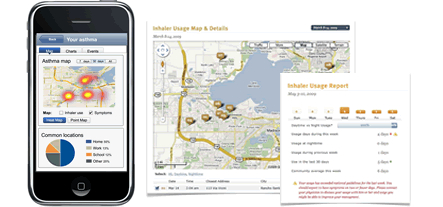 Back in April 2009 we reported that David Van Sickle, a recent Robert Wood Johnson Foundation Health and Society Scholar in the Department of Population Health Sciences at the University of Wisconsin-Madison, was developing a GPS add-on for asthmatics’ inhalers to map where and when environmental exposures cause asthma symptoms--as well as alert users and encourage them to puff on the “rescue inhaler.” The project was also aimed at mapping the unknown causes of asthma in the environment.
Back in April 2009 we reported that David Van Sickle, a recent Robert Wood Johnson Foundation Health and Society Scholar in the Department of Population Health Sciences at the University of Wisconsin-Madison, was developing a GPS add-on for asthmatics’ inhalers to map where and when environmental exposures cause asthma symptoms--as well as alert users and encourage them to puff on the “rescue inhaler.” The project was also aimed at mapping the unknown causes of asthma in the environment.
Van Sickle has emerged again with a commercial product slated for release in the fall by his Asthmapolis research company. The Spiroscout builds on Van Sickle's earlier ideas: the GPS and WiFi-enabled device is "small and lightweight, easy to mount securely on the end of most inhalers, and simple to transfer to a new canister," according to the product page. "Lights on the device let you know when it has detected use, and also show remaining battery level," the company says. Everytime a use takes a dose of their medication from the inhaler, the device records the time and location for later trasmission back to a computer.
The device will provide a much needed upgrade to the handwritten use-logs patients are supposed to be writing to help their doctors understand their condition. Additionally, epidemiologists will have more accurate data to analyze about asthma sufferers as well as GPS-based air quality trends.The new device is an upgrade from Van Sickle's 2009 device SilonSky GPS which required an extra box that users would have to carry around -- now the GPS unit just sits right on top of the inhaler.
In March the Robert Wood Johnson Foundation’s (RWJF) Project HealthDesign team awarded a total of $2.4 million to five research teams that each aim to determine how patient-recorded observations of daily living (ODLs) can be captured and included into clinical care. One of those five teams was RTI International and Virginia Commonwealth University who are designing BreathEasy, a self-monitoring application for patients with asthma and depression. Patients interact with the application through smartphones and biomonitors capturing ODLs such as use of controller and rescue medications and symptom levels, while Clinicians use a Web-based dashboard providing simple analysis and visualization tools of patient data.
Asthmapolis' device is reminiscent of TEDMED talk MobiHealthNews attended in 2009 that argued our EHRs should include a record of where we have lived -- air quality and other geo-specific factors should be a part of our care record. Devices like the Spiroscout may be the early tools we use to do just that.
For more, read the Engadget story, and Physorg.com



















